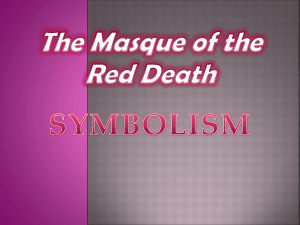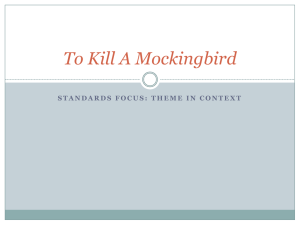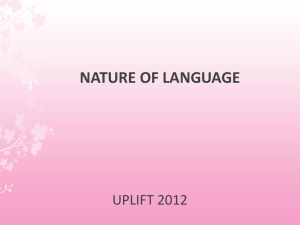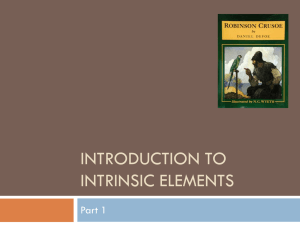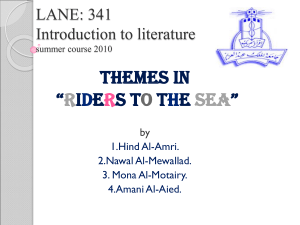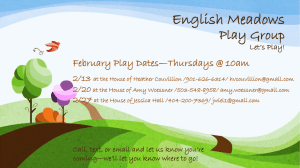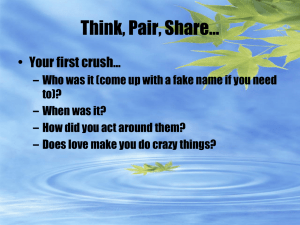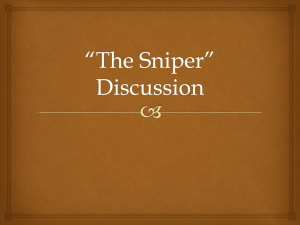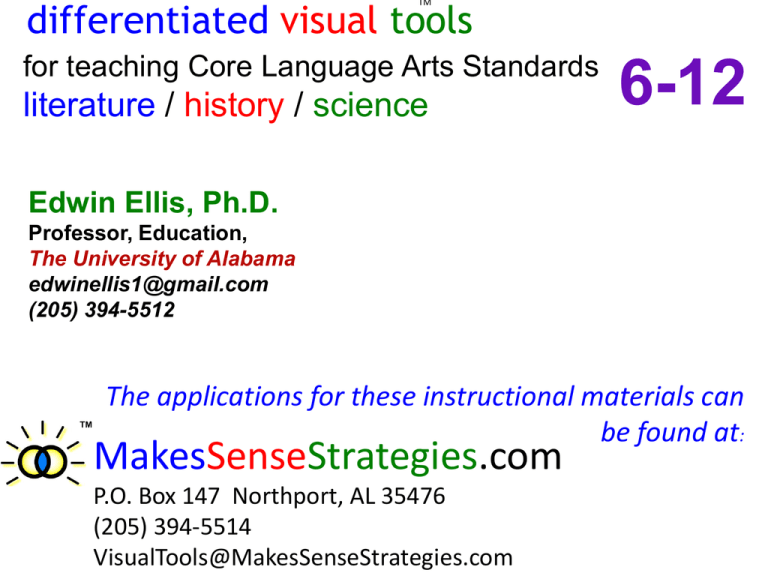
differentiated visual tools
TM
for teaching Core Language Arts Standards
literature / history / science
6-12
Edwin Ellis, Ph.D.
Professor, Education,
The University of Alabama
edwinellis1@gmail.com
(205) 394-5512
TM
The applications for these instructional materials can
be found at:
MakesSenseStrategies.com
P.O. Box 147 Northport, AL 35476
(205) 394-5514
VisualTools@MakesSenseStrategies.com
differentiated visual tools
TM
ADVANCE ORGANIZER
Part 1: WHAT are differentiated visual tools?
HOW do DVTs differ from traditional graphic organizers?
WHAT’s so “differentiated” about DVTs?
WHY are they so effective?
* Different DVTs for different Core Standards
* Different DVTs for students with different levels of development
* Different DVTs structure for success via prompts that focus on
critical thinking & essential understandings of discipline-specific
topics
Part 2: HOW/WHEN are differentiated visual tools
used when teaching?
Part 3: HOW effective are differentiated visual tools?
differentiated visual tools
TM
ADVANCE ORGANIZER
Part 1: WHAT are differentiated visual tools?
HOW do DVTs differ from traditional graphic organizers?
WHAT’s so “differentiated” about DVTs?
WHY are they so effective?
* Different DVTs for different Core Standards
* Different DVTs for students with different levels of development
* Different DVTs structure for success via prompts that focus on
critical thinking & essential understandings of discipline-specific
topics
Focus of this presentation
The DVTs featured in this presentation are from the the
following applications:
differentiated visual tools
TM
Grades 6-8
for teaching Core LITERATURE Language Arts Standards
differentiated visual tools
TM
Grades 6-8
for teaching Core HISTORY Language Arts Standards
differentiated visual tools
TM
BIG IDEAS
generic graphic organizers
…very effective for simple Core LA Standards
…not so great as Core standards get more complex
Cite strong and thorough textual
evidence to support analysis of
what the text says explicitly as
well as inferences drawn from the
text, including determining where
the text leaves matters uncertain.
(11-12th grade)
Delineate and evaluate the argument
and specific claims in a text,
assessing whether the reasoning is
valid and the evidence is relevant and
sufficient; identify false statements
and fallacious reasoning. (8th grade)
differentiated visual tools
TM
BIG IDEAS
These are your PARENTS’ graphic organizers
GRANDPARENTS’
generic graphic organizers
…very effective for simple Core LA Standards
…not so great as Core standards get more complex
Cite strong and thorough textual
evidence to support analysis of
what the text says explicitly as
well as inferences drawn from the
text, including determining where
the text leaves matters uncertain.
(11-12th grade)
Delineate and evaluate the argument
and specific claims in a text,
assessing whether the reasoning is
valid and the evidence is relevant and
sufficient; identify false statements
and fallacious reasoning. (8th grade)
KEY WORDS / PHRASES TO WATCH FOR…
Content-literacy standards vs. content standards
Generic visuals vs. differentiated visuals
Discipline-specific visuals for specific Core standards
Structure for success
Embedded prompts for critical thinking & essential
understandings
Reduce the cognitive load
SEE how complex standards are addressed in clear and
simple ways
SEE the thinking processes involved in learning specific
Core Standards
© 2013 Edwin S. Ellis
All Rights Reserved
edwinellis1@gmail.com
www.MakesSenseStrategies.com
2 MAJOR KINDS of STANDARDS in Grades 6-12…
CONTENT LITERACY STANDARDS
CONTENT STANDARDS
(e.g., Common Core LA Standards for
Literature, History & Science)
(e.g., Knowledge Standards for
Literature, History & Science)
…address thinking & information
processing skills, as applied in
different ways to different
disciplines
© 2013 Edwin S. Ellis
All Rights Reserved
…address relational
understanding of information
edwinellis1@gmail.com www.GraphicOrganizers.com
2 MAJOR KINDS of STANDARDS in Grades 6-12…
CONTENT LITERACY STANDARDS
CONTENT STANDARDS
(e.g., Common Core LA Standards for
Literature, History & Science)
(e.g., Knowledge Standards for
Literature, History & Science)
…address thinking & information
processing skills, as applied in
different ways to different
disciplines
…address relational
understanding of information
CATEGORY 1:
Inferences / Summaries /
Comparisons / CE relationships
CATEGORY 2:
Analyzing Author’s Point-of-View,
Reasoning & Evidence
CATEGORY 3:
Researching, Writing, Presenting
© 2013 Edwin S. Ellis
All Rights Reserved
edwinellis1@gmail.com www.GraphicOrganizers.com
2 MAJOR KINDS of STANDARDS in Grades 6-12…
CONTENT LITERACY STANDARDS
CONTENT STANDARDS
(e.g., Common Core LA Standards for
Literature, History & Science)
(e.g., Knowledge Standards for
Literature, History & Science)
…address thinking & information
processing skills, as applied in
different ways to different
disciplines
CATEGORY 1:
Inferences / Summaries /
Comparisons / CE relationships
© 2013 Edwin S. Ellis
All Rights Reserved
…address relational
understanding of information
For example…
RI.6.1 Cite textual evidence to
support analysis of what the text
says explicitly as well as
inferences drawn from the text.
edwinellis1@gmail.com www.GraphicOrganizers.com
2 MAJOR KINDS of STANDARDS in Grades 6-12…
CONTENT LITERACY STANDARDS
CONTENT STANDARDS
(e.g., Common Core LA Standards for
Literature, History & Science)
(e.g., Knowledge Standards for
Literature, History & Science)
…address thinking & information
processing skills, as applied in
different ways to different
disciplines
CATEGORY 1:
Inferences / Summaries /
Comparisons / CE relationships
© 2013 Edwin S. Ellis
All Rights Reserved
…address relational
understanding of information
For example…
RI.6.1 Cite textual evidence to
support analysis of what the text
says explicitly as well as
inferences drawn from the text.
edwinellis1@gmail.com www.GraphicOrganizers.com
2 MAJOR KINDS of STANDARDS in Grades 6-12…
CONTENT LITERACY STANDARDS
CONTENT STANDARDS
(e.g., Common Core LA Standards for
Literature, History & Science)
(e.g., Knowledge Standards for
Literature, History & Science)
…address thinking & information
processing skills, as applied in
different ways to different
disciplines
CATEGORY 1:
Inferences / Summaries /
Comparisons / CE relationships
© 2013 Edwin S. Ellis
All Rights Reserved
…address relational
understanding of information
For example…
RI.6.2 Determine a central idea of a
text and how it is conveyed
through particular details; provide
a summary of the text distinct from
personal opinions or judgments.
edwinellis1@gmail.com www.GraphicOrganizers.com
2 MAJOR KINDS of STANDARDS in Grades 6-12…
CONTENT LITERACY STANDARDS
CONTENT STANDARDS
(e.g., Common Core LA Standards for
Literature, History & Science)
(e.g., Knowledge Standards for
Literature, History & Science)
…address thinking & information
processing skills, as applied in
different ways to different
disciplines
CATEGORY 1:
Inferences / Summaries /
Comparisons / CE relationships
© 2013 Edwin S. Ellis
All Rights Reserved
…address relational
understanding of information
For example…
RI.6.2 Determine a central idea of a
text and how it is conveyed
through particular details; provide
a summary of the text distinct from
personal opinions or judgments.
edwinellis1@gmail.com www.GraphicOrganizers.com
2 MAJOR KINDS of STANDARDS in Grades 6-12…
CONTENT LITERACY STANDARDS
CONTENT STANDARDS
(e.g., Common Core LA Standards for
Literature, History & Science)
(e.g., Knowledge Standards for
Literature, History & Science)
…address thinking & information
processing skills, as applied in
different ways to different
disciplines
CATEGORY 1:
Inferences / Summaries /
Comparisons / CE relationships
© 2013 Edwin S. Ellis
All Rights Reserved
…address relational
understanding of information
For example…
RL.8.2. Determine a theme or
central idea of a text and analyze
its development over the course of
the text, including its relationship
to the characters, setting, and plot;
provide an objective summary of
the text.
edwinellis1@gmail.com www.GraphicOrganizers.com
2 MAJOR KINDS of STANDARDS in Grades 6-12…
CONTENT LITERACY STANDARDS
CONTENT STANDARDS
(e.g., Common Core LA Standards for
Literature, History & Science)
(e.g., Knowledge Standards for
Literature, History & Science)
…address thinking & information
processing skills, as applied in
different ways to different
disciplines
CATEGORY 1:
Inferences / Summaries /
Comparisons / CE relationships
© 2013 Edwin S. Ellis
All Rights Reserved
…address relational
understanding of information
For example…
RL.8.2. Determine a theme or
central idea of a text and analyze
its development over the course of
the text, including its relationship
to the characters, setting, and plot;
provide an objective summary of
the text.
edwinellis1@gmail.com www.GraphicOrganizers.com
2 MAJOR KINDS of STANDARDS in Grades 6-12…
CONTENT LITERACY STANDARDS
CONTENT STANDARDS
(e.g., Common Core LA Standards for
Literature, History & Science)
(e.g., Knowledge Standards for
Literature, History & Science)
…address thinking & information
processing skills, as applied in
different ways to different
disciplines
CATEGORY 1:
Inferences / Summaries /
Comparisons / CE relationships
© 2013 Edwin S. Ellis
All Rights Reserved
…address relational
understanding of information
For example…
RI. 8.3 Analyze how a text makes
connections among and
distinctions between individuals,
ideas, or events (e.g., through
comparisons, analogies, or
categories).
edwinellis1@gmail.com www.GraphicOrganizers.com
2 MAJOR KINDS of STANDARDS in Grades 6-12…
CONTENT LITERACY STANDARDS
CONTENT STANDARDS
(e.g., Common Core LA Standards for
Literature, History & Science)
(e.g., Knowledge Standards for
Literature, History & Science)
…address thinking & information
processing skills, as applied in
different ways to different
disciplines
CATEGORY 1:
Inferences / Summaries /
Comparisons / CE relationships
© 2013 Edwin S. Ellis
All Rights Reserved
…address relational
understanding of information
For example…
RI. 8.3 Analyze how a text makes
connections among and
distinctions between individuals,
ideas, or events (e.g., through
comparisons, analogies, or
categories).
edwinellis1@gmail.com www.GraphicOrganizers.com
2 MAJOR KINDS of STANDARDS in Grades 6-12…
CONTENT LITERACY STANDARDS
CONTENT STANDARDS
(e.g., Common Core LA Standards for
Literature, History & Science)
(e.g., Knowledge Standards for
Literature, History & Science)
…address thinking & information
processing skills, as applied in
different ways to different
disciplines
CATEGORY 2:
Analyzing Author’s Point-of-View,
Reasoning & Evidence
© 2013 Edwin S. Ellis
All Rights Reserved
…address relational
understanding of information
For example…
RI.7.8 Trace and evaluate the
argument and specific claims in a
text, assessing whether the
reasoning is sound and the
evidence is relevant and sufficient
to support the claims.
edwinellis1@gmail.com www.GraphicOrganizers.com
2 MAJOR KINDS of STANDARDS in Grades 6-12…
CONTENT LITERACY STANDARDS
CONTENT STANDARDS
(e.g., Common Core LA Standards for
Literature, History & Science)
(e.g., Knowledge Standards for
Literature, History & Science)
…address thinking & information
processing skills, as applied in
different ways to different
disciplines
CATEGORY 2:
Analyzing Author’s Point-of-View,
Reasoning & Evidence
© 2013 Edwin S. Ellis
All Rights Reserved
…address relational
understanding of information
For example…
RI.7.8 Trace and evaluate the
argument and specific claims in a
text, assessing whether the
reasoning is sound and the
evidence is relevant and sufficient
to support the claims.
edwinellis1@gmail.com www.GraphicOrganizers.com
Four big challenges…
1. Some of the Common Core standards are
really complex
CATEGORY 1:
Inferences / Summaries /
Comparisons / CE
relationships
CATEGORY 2:
Analyzing Author’s
Point-of-View,
Reasoning & Evidence
CATEGORY 3:
Researching, Writing,
Presenting
Delineate and evaluate the argument
and specific claims in a text,
assessing whether the reasoning is
valid and the evidence is relevant and
sufficient; identify false statements
and fallacious reasoning. (8th grade)
Cite strong and thorough textual
evidence to support analysis of
what the text says explicitly as
well as inferences drawn from the
text, including determining where
the text leaves matters uncertain.
(11-12th grade)
© 2013 Edwin S. Ellis All Rights Reserved edwinellis1@gmail.com www.GraphicOrganizers.com
Four big challenges…
1. Some of the Common Core standards are
really complex
Each skill-area has a
scope and sequence 2. Attempting to teach grade-level standards
when critical prerequisite skills haven’t been
gradually developed over time
CATEGORY 1:
Inferences / Summaries /
Comparisons / CE
relationships
RL.2.2. Recount stories, including fables and folktales from diverse cultures,
and determine their central message, lesson, or moral.
RL.3.2. Recount stories, including fables, folktales, and myths from diverse
cultures; determine the central message, lesson, or moral and explain
how it is conveyed through key details in the text.
RL.3.9. Compare and contrast the themes, settings, and plots of stories written
by the same author about the same or similar characters (e.g., in books
from a series).
RL.4.2. Determine a theme of a story, drama, or poem from details in the text;
summarize the text.
RL.4.9. Compare and contrast the treatment of similar themes and topics (e.g.,
opposition of good and evil) and patterns of events (e.g., the quest) in
stories, myths, and traditional literature from different cultures.
RL.5.2. Determine a theme of a story, drama, or poem from details in the text,
including how characters in a story or drama respond to challenges or
how the speaker in a poem reflects upon a topic; summarize the text.
RL.6.2. Determine a theme or central idea of a text and how it is conveyed
through particular details; provide a summary of the text distinct from
personal opinions or judgments.
RL.7.2. Determine a theme or central idea of a text and analyze its development
over the course of the text; provide an objective summary of the text.
RL.8.2. Determine a theme or central idea of a text and analyze its development
over the course of the text, including its relationship to the characters,
setting, and plot; provide an objective summary of the text.
RL.9-10.2. Determine a theme or central idea of a text and analyze in detail its
development
over the coursewww.GraphicOrganizers.com
of the text, including how it emerges and
© 2013 Edwin S. Ellis All Rights
Reserved edwinellis1@gmail.com
is shaped and refined by specific details; provide an objective summary
CATEGORY 2:
Analyzing Author’s
Point-of-View,
Reasoning & Evidence
CATEGORY 3:
Researching, Writing,
Presenting
Trying to teach this grade-level standard…
Four big challenges…
1. Some of the Common Core standards are
really complex
Each skill-area has a
scope and sequence 2. Attempting to teach grade-level standards
when critical prerequisite skills haven’t been
gradually developed over time
CATEGORY 1:
Inferences / Summaries /
Comparisons / CE
relationships
RL.2.2. Recount stories, including fables and folktales from diverse cultures,
and determine their central message, lesson, or moral.
RL.3.2. Recount stories, including fables, folktales, and myths from diverse
cultures; determine the central message, lesson, or moral and explain
how it is conveyed through key details in the text.
RL.3.9. Compare and contrast the themes, settings, and plots of stories written
by the same author about the same or similar characters (e.g., in books
from a series).
RL.4.2. Determine a theme of a story, drama, or poem from details in the text;
summarize the text.
RL.4.9. Compare and contrast the treatment of similar themes and topics (e.g.,
opposition of good and evil) and patterns of events (e.g., the quest) in
stories, myths, and traditional literature from different cultures.
RL.5.2. Determine a theme of a story, drama, or poem from details in the text,
including how characters in a story or drama respond to challenges or
how the speaker in a poem reflects upon a topic; summarize the text.
RL.6.2. Determine a theme or central idea of a text and how it is conveyed
through particular details; provide a summary of the text distinct from
personal opinions or judgments.
RL.7.2. Determine a theme or central idea of a text and analyze its development
over the course of the text; provide an objective summary of the text.
RL.8.2. Determine a theme or central idea of a text and analyze its development
over the course of the text, including its relationship to the characters,
setting, and plot; provide an objective summary of the text.
RL.9-10.2. Determine a theme or central idea of a text and analyze in detail its
development
over the coursewww.GraphicOrganizers.com
of the text, including how it emerges and
© 2013 Edwin S. Ellis All Rights
Reserved edwinellis1@gmail.com
is shaped and refined by specific details; provide an objective summary
CATEGORY 2:
Analyzing Author’s
Point-of-View,
Reasoning & Evidence
CATEGORY 3:
Researching, Writing,
Presenting
When very little of this has
been previously addressed
Trying to teach this grade-level standard…
Four big challenges…
1. Some of the Common Core standards
are really complex
2. Attempting to teach grade-level
standards when critical prerequisite
skills haven’t been gradually developed
over time
3. Balancing instruction in content-literacy
skills (Common Core Standards) with
instruction in content standards (history
/ science knowledge)
Core
literacy skills
history / science
knowledge
Four big challenges…
1. Some of the Common Core standards
are really complex
2. Attempting to teach grade-level
standards when critical prerequisite
skills haven’t been gradually developed
over time
3. Balancing instruction in content-literacy
skills (Common Core Standards) with
instruction in content standards (history
/ science knowledge)
To $$cash$$ in on
the CCS
movement,
commercial
publishers have
been RUSHING
to get stuff out
© 2013 Edwin S. Ellis
4. Access to CCS instructional resources
that have a compelling research base
All Rights Reserved
edwinellis1@gmail.com www.GraphicOrganizers.com
Four big challenges…
1. Some of the Common Core standards
are really complex
2. Attempting to teach grade-level
standards when critical prerequisite
skills haven’t been gradually
developed over time
3. Balancing instruction in content-literacy
skills (Common Core Standards) with
instruction in content standards (history
/ science knowledge)
To $$cash$$ in on
the CCS
movement,
commercial
publishers have
been RUSHING
to get stuff out
© 2013 Edwin S. Ellis
4. Access to CCS instructional resources
that have a compelling research base
NOT SO
MUCH
All Rights Reserved
edwinellis1@gmail.com www.GraphicOrganizers.com
literature & information text + writing K-5
The standards are arranged developmentally
In each category, they become increasingly complex
RL 6.2 Determine a theme or central idea of a text and how
it is conveyed through particular details; provide a
summary of the text distinct from personal
opinions or judgments.
Webs can be
excellent visual tools
for teaching basic
summarization skills
RL 7.2 Determine a theme or central idea of a text and
analyze its development over the course of the text;
provide an objective summary of the text.
…but are webs the
best tools for
addressing
complex Core
Standards?
RL 9-10.2 Determine a theme or central idea of a text and
analyze in detail its development over the course of
the text, including how it emerges and is shaped
and refined by specific details; provide an objective
summary of the text.
RL 8.2
Determine a theme or central idea of a text and
analyze its development over the course of the text,
including its relationship to the characters, setting,
and plot; provide an objective summary of the text.
RL 11-12-Determine two or more themes or central ideas of a
text and analyze their development over the course
of the text, including how they interact and build on
one another to produce a complex account; provide
an objective summary of the text.
Let’s say you are attempting to teaching this standard…
RL.9-10.2. Determine a theme or central idea of a text and analyze in detail its
development over the course of the text, including how it emerges
and is shaped and refined by specific details; provide an objective
summary of the text.
What’s the difference between…
THIS
…and THIS?
© 2013 Edwin S. Ellis All Rights Reserved edwinellis1@gmail.com www.GraphicOrganizers.com
LITERARY WORK
(title of story, chapter,
poem, etc.)
The Pardoner’s Tale
by Geoffrey Chaucer
To identify the TOPIC of the story, ask yourself…What is this story about? Answer your question in 1-3 words. (see the COMMON STORY TOPICS list for ideas)
To identify the THEME of the story, ask yourself…What is author’s unstated message or opinion about the topic? (see COMMON LITERATURE THEMES list for ideas)
TOPIC of the story
Loyalty
THEME of the story is (author’s unstated opinion or message about the story’s topic)
Betraying your friends will lead to your own downfall.
Evidence of the theme may be an event, how characters reacted to the event, a character’s personality, how a character acts, what
happened to characters, a quote, etc. that seems to convey the author’s message or opinion about the topic if the story.
Description of an EVENT, CHARACTER, or SETTING CONNECTIONS TO THE THEME
Because they have all gotten drunk together they say
they are loyal to each other when they’re not. (False
friends often turn on each other.)
CHARACTER- The three rioters have been in
a bar all night long and are very drunk.
X
Literary device used in the connection
Explanation…
Irony
Satire
Parody
Motivation
Personification
Symbolism
Other
Ironic because it seems like they are really good friends, so you would expect them to help
each other out and share stuff, but the reality is, they end up doing the opposite.
When the three rioters find the gold under the tree,
each starts thinking about getting rich – selfishness
quickly replaces loyalty
SETTING - The gold under the tree
Literary device used in the connection
Explanation…
Irony
Satire
Parody
Motivation
Personification
X
Symbolism
Other
The gold symbolizes greed and show how it can make people turn on each other.
EVENT - The three robbers end up killing
each other
Literary device used in the connection
Explanation…
Irony
Satire
Parody
Because they all turned their backs on each other to
try and keep more of the gold, they all ended up dead.
X
Motivation
Personification
Symbolism
Other
Author uses motivation (to get rich) to drive home the theme that “betraying your friends will lead to
you downfall – in this case, your death
The Pardoner’s Tale
The Pardoner’s Tale by Geoffrey Chaucer is a story
about loyalty, or rather the lack of it. I think
Chaucer’s message about life is “Betraying your
friends will lead to downfall.” For example, one of
the ways Chaucer communicates this message is by
his use of characters and irony. Three rioters have
been in a bar all night and have gotten very drunk.
They talk about how loyal they are to each other and
how they have become brothers. In reality, they just
met each other in a bar and are not loyal to each
other at all. They’re just drunk. Basically Chaucer is
saying that false friends will turn on each other.
Chaucer uses irony to set the stage in this part of the story to establish that the so-called loyal
friends are about to betray each other later in the story.
Chaucer also uses the setting of the story and symbolism to communicate the betrayal theme.
There’s a particular setting where there is a bag of gold under a tree. The gold symbolizes greed
and shows how it can make people turn on each other. The men think that is they take the gold,
they will be very happy. In other words, the greed of the riotors will far outweigh any false loyalty
they may have toward each other. Each wants the gold for himself.
The three robbers end up killing each other. Here, Chaucer uses an event in the story and
motivation as a literary device to illustrate the betrayal theme. Because they all turned their
backs on each other to try and keep more of the gold, they all ended up dead.
Chaucer use of irony, symbolism, and motivation all relate to the story’s theme of loyalty. A
theme is a message about life, and the message here is that false friends turn on each other. If
the thieves were true friends, they wouldn’t have killed each other because of greed for the gold.
What’s the difference between…
THIS
…and THIS?
It’s all about the prompts!
* Clear & explicit
* Guide thinking * Simple
* Standard-specific
© 2013 Edwin S. Ellis All Rights Reserved edwinellis1@gmail.com www.GraphicOrganizers.com
DVTs structure for success via embedded critical thinking &
essential understandings prompts that reduce the cognitive
load without dumbing down the curriculum
DVTs allow teachers to SEE how to explicitly address
complex standards in clear and simple ways
DVTs allow students to SEE the thinking processes involved
in learning specific Core Standards
What’s the difference between…
THIS
…and THIS?
More
about this
later
It’s all about the prompts!
* Clear & explicit
* Guide thinking * Simple
This is
HUGE!
* Standard-specific
© 2013 Edwin S. Ellis All Rights Reserved edwinellis1@gmail.com www.GraphicOrganizers.com
Thus, we don’t start with
something this complex…
…rather, we build up to it
© 2013 Edwin S. Ellis
All Rights Reserved
edwinellis1@gmail.com www.GraphicOrganizers.com
Thus, we don’t start with
something this complex…
…rather, we build up to it
© 2013 Edwin S. Ellis
All Rights Reserved
edwinellis1@gmail.com www.GraphicOrganizers.com
Thus, we don’t start with
something this complex…
…rather, we build up to it
FOR EXAMPLE…
© 2013 Edwin S. Ellis
All Rights Reserved
edwinellis1@gmail.com www.GraphicOrganizers.com
STORY
Mufaro’s Beautiful Daughters
by John Steptoe
What was the message about life in the story?
I think the message was that being kind and good to people makes you
happier and leads to a better life.
Reason why I think this is the message…
Nyasha was kind to
everyone.
Another reason why I think it is the message…
Manyara was mean to her
sister and everyone.
Details
Details
She did not try to hurt her sister
who was mean to her.
She was also mean to a little boy
who was really the king.
She was chosen to be queen
because of her kindness.
Manyara ended up being a servant
to her sister.
CONCLUSION: Is the message important? Why?
The message is important because if you are mean to others, you will always be
unhappy and just want to be even meaner.
Thus, we don’t start with
something this complex…
…rather, we build up to it
FOR EXAMPLE…
© 2013 Edwin S. Ellis
All Rights Reserved
edwinellis1@gmail.com www.GraphicOrganizers.com
STORY
Many stories reflect one or more of a series of common topics, patterns, set of actions or events. Below is a list of some of the most common
authors like to write about. Decide whether the story you read reflects one of these patterns and why you think so.
Quest for
global good
The Feud
Quest for identity
Coming
of age
Preserving Innocence
Confronting
moral evil
Loss of Pride
Quest for
self-assurance
Being tested / trials
Searching
for self
Decent to the
Underworld
Decay
Quest for security
Rite of passage
Finding meaning
in life
Falling from
grace
The Epic
Quest for kin
The Initiation
Learning something
about self
Expulsion /
Rejection
Annihilation
Emotional or
physical journey
Rejecting / bonding
with parents
Finding
acceptance
Loss of
Innocence
Birth, death
& rebirth
Quest for
material wealth
Rejecting / accepting
authority
Absurdity of life
1st Reason + evidence why I think the story is about the topic(s) I
selected…
2nd Reason + evidence why I think the story is about the topic(s) I
selected…
CONCLUSION: What is important to understand about the topic(s)?
Thus, we don’t start with
something this complex…
…rather, we build up to it
FOR EXAMPLE…
© 2013 Edwin S. Ellis
All Rights Reserved
edwinellis1@gmail.com www.GraphicOrganizers.com
LITERARY WORK
(title of story, chapter,
poem, etc.)
The Case of the Missing Marquess by Nancy Springer
To identify the TOPIC of the story, ask yourself…What is this story about? Answer your question in 1-3 words. (see the COMMON STORY TOPICS list for ideas)
To identify the THEME of the story, ask yourself…What is author’s unstated message or opinion about the topic? (see COMMON LITERATURE THEMES list for ideas)
TOPIC of the story
Being independent
THEME of the story is (author’s unstated opinion or message about the story’s topic)
Self-reliance rules! (never give in to social pressures or expectations to be dependent)
Evidence of the theme may be an event, how characters reacted to the event, a character’s personality, how a character acts, what
happened to characters, a quote, etc. that seems to convey the author’s message or opinion about the topic of the story.
Description of an EVENT, CHARACTER, or SETTING CONNECTIONS TO THE THEME
Enola’s mother raised her to believe that
she could live on her own. She also
allowed her to wear clothes (i.e. no
corset) and go places that other young
girls were not allowed to go on their own.
Rather than relying on her brothers,
Enola went off on her own to find her
mother who disappeared. She wore a
disguise, and went out at night through
the slums of London. She went against
what a ‘proper’ lady would do.
Pg.5 “You will do very well on your own, Enola,” she would tell me nearly
every day as I was growing up.
Pg. 16,17 “I knew my mother was criticized for failing properly to
drape vulgar surfaces and me.” Pg 34
The Case of the Missing Marquess shows how important it is to raise
your children to have confidence in themselves and to strive for
independence.
Pg. 1 “It was unthinkable for a female to venture out at night without
the escort of a husband, father, or brother. But she will do whatever
she must in order to search for the one who is lost.”
Enola shows that an important part of believing in you is to put
yourself out there or take risks.
So what? What is important to understand about the theme of the story?
Everyone experiences the same basic circles of life, although they happen in different times and ways
Thus, we don’t start with
something this complex…
…rather, we build up to it
FOR EXAMPLE…
© 2013 Edwin S. Ellis
All Rights Reserved
edwinellis1@gmail.com www.GraphicOrganizers.com
A Gathering of Days by Joan W. Blos
LITERARY WORK
(title of story, chapter,
poem, etc.)
To identify the TOPIC of the story, ask yourself…What is this story about? Answer your question in 1-3 words. (see the COMMON STORY TOPICS list for ideas)
To identify the THEME of the story, ask yourself…What is author’s unstated message or opinion about the topic? (see COMMON LITERATURE THEMES list for ideas)
TOPIC of the story
THEME of the story is (author’s unstated opinion or message about the story’s topic)
Circle of life
There are many circles of life that overlap.
Evidence of the theme may be an event, how characters reacted to the event, a character’s personality, how a character acts, what
happened to characters, a quote, etc. that seems to convey the author’s message or opinion about the topic if the story.
Description of an EVENT, CHARACTER, or SETTING CONNECTIONS TO THE THEME
One of the “life circles” is about dealing with challenges or
problems. Catherine wrote a journal when she was 14, and
then gave it to her great-granddaughter when she was 14.
The journal is about challenges Catherine had, and how she
coped with them, and then moved on with her life until she
faced a new challenge, and so on.
Literary device used in the connection
Explanation…
Irony
Satire
Parody
Catherine lost her mother and little brother when she was
9 years old. With the help of a neighbor, Mrs. Shipman and
her little sister, she took care of running the household.
She learned how to cope with the challenges.
X
Motivation
Personification
Symbolism
Other
Catherine used all of the hardships she faced as a sort of fuel to motivation herself not to give up. It was almost like
she refused to let anything keep her down. The Circle of Life here was basically a hardship comes, she gets upset at
first, and then she starts to deal with it. Eventually, she “moves on”. Then another hardship hits, and she goes through
the same cirlce.
Description of an EVENT, CHARACTER, or SETTING CONNECTIONS TO THE THEME
One of the “life circles” is about the seasons of life.
Catherine’s journal is about the seasons of life on a farm.
Each season brings new promises, different jobs on a farm,
new challenges and joys and then starts all over again the
next year.
Literary device used in the connection
Explanation…
Irony
Satire
Parody
Page 51 - “At mid-day today the storm let up; by dusk a few
pale shadows appeared on the hillock’d snow. Father
expects that tomorrow with be the day of the breaking
out.”
Page 121 “The sap, they say, is running in the better
sheltered trees.”/ “Haying, mowing, gathering in!”
Motivation
Personification
X
Symbolism
Other
Seasons of life” like = Spring (new beginning or new problem) Summer = (grow up – deal with problem ) Fall – become adult
– don’t view it as such a big problem anymore
Winter – get old – problem = old news
Thus, we don’t start with
something this complex…
…rather, we build up to it
FOR EXAMPLE…
© 2013 Edwin S. Ellis
All Rights Reserved
edwinellis1@gmail.com www.GraphicOrganizers.com
LITERARY WORK
(title of story, chapter,
poem, etc.)
The Pardoner’s Tale
by Geoffrey Chaucer
To identify the TOPIC of the story, ask yourself…What is this story about? Answer your question in 1-3 words. (see the COMMON STORY TOPICS list for ideas)
To identify the THEME of the story, ask yourself…What is author’s unstated message or opinion about the topic? (see COMMON LITERATURE THEMES list for ideas)
TOPIC of the story
Loyalty
THEME of the story is (author’s unstated opinion or message about the story’s topic)
Betraying your friends will lead to your own downfall.
Evidence of the theme may be an event, how characters reacted to the event, a character’s personality, how a character acts, what
happened to characters, a quote, etc. that seems to convey the author’s message or opinion about the topic if the story.
Description of an EVENT, CHARACTER, or SETTING CONNECTIONS TO THE THEME
Because they have all gotten drunk together they say
they are loyal to each other when they’re not. (False
friends often turn on each other.)
CHARACTER- The three rioters have been in
a bar all night long and are very drunk.
X
Literary device used in the connection
Explanation…
Irony
Satire
Parody
Motivation
Personification
Symbolism
Other
Ironic because it seems like they are really good friends, so you would expect them to help
each other out and share stuff, but the reality is, they end up doing the opposite.
When the three rioters find the gold under the tree,
each starts thinking about getting rich – selfishness
quickly replaces loyalty
SETTING - The gold under the tree
Literary device used in the connection
Explanation…
Irony
Satire
Parody
Motivation
Personification
X
Symbolism
Other
The gold symbolizes greed and show how it can make people turn on each other.
EVENT - The three robbers end up killing
each other
Literary device used in the connection
Explanation…
Irony
Satire
Parody
Because they all turned their backs on each other to
try and keep more of the gold, they all ended up dead.
X
Motivation
Personification
Symbolism
Other
Author uses motivation (to get rich) to drive home the theme that “betraying your friends will lead to
you downfall – in this case, your death
BIG IDEA Differentiated Visual Tools are scaffolded
Thus, we don’t start with
something this complex…
…rather, we build up to it
IMPLICATIONS?
Instruction can be DIFFERENTIATED based on the sophistication
of the learner & the complexity of the Visual Tool
© 2013 Edwin S. Ellis
All Rights Reserved
edwinellis1@gmail.com www.GraphicOrganizers.com
Important to understand…
differentiated visual tools are not limited to
literature theme analysis
CATEGORY 1:
Inferences / Summaries /
Comparisons / CE
relationships
CATEGORY 2:
Analyzing Author’s
Point-of-View,
Reasoning & Evidence
CATEGORY 3:
Researching, Writing,
Presenting
© 2013 Edwin S. Ellis
theme
analysis
There are strands of developmentally
sequenced DVTS for each of the major
areas of Core Standards
All Rights Reserved
edwinellis1@gmail.com www.GraphicOrganizers.com
Important to understand…
differentiated visual tools are not limited to
literature theme analysis
CATEGORY 1:
Inferences / Summaries /
Comparisons / CE
relationships
CATEGORY 2:
Analyzing Author’s
Point-of-View,
Reasoning & Evidence
CATEGORY 3:
Researching, Writing,
Presenting
© 2013 Edwin S. Ellis
theme
analysis
drawing
inferences
There are strands of developmentally
sequenced DVTS for each of the major
areas of Core Standards
All Rights Reserved
edwinellis1@gmail.com www.GraphicOrganizers.com
Important to understand…
differentiated visual tools are not limited to
literature theme analysis
CATEGORY 1:
Inferences / Summaries /
Comparisons / CE
relationships
CATEGORY 2:
Analyzing Author’s
Point-of-View,
Reasoning & Evidence
CATEGORY 3:
Researching, Writing,
Presenting
© 2013 Edwin S. Ellis
theme
analysis
drawing
inferences
making
comparisons
There are strands of developmentally
sequenced DVTS for each of the major
areas of Core Standards
All Rights Reserved
edwinellis1@gmail.com www.GraphicOrganizers.com
Important to understand…
differentiated visual tools are not limited to
literature theme analysis
CATEGORY 1:
Inferences / Summaries /
Comparisons / CE
relationships
CATEGORY 2:
Analyzing Author’s
Point-of-View,
Reasoning & Evidence
CATEGORY 3:
Researching, Writing,
Presenting
© 2013 Edwin S. Ellis
theme
analysis
ETC
drawing
inferences
making
comparisons analyzing
PoV
There are strands of developmentally
sequenced DVTS for each of the major
areas of Core Standards
All Rights Reserved
edwinellis1@gmail.com www.GraphicOrganizers.com
© 2013 Edwin S. Ellis
All Rights Reserved
edwinellis1@gmail.com
Bald Eagle
DIFFERENT
www.MakesSenseStrategies.com
Red-Tailed Hawk
SIMILAR
DIFFERENT
They eat fish and
use their talons or
claws to catch them.
Carnivores
They live near lakes,
rivers, marshes, and
seacoasts.
Temperate Deciduous
Forest
They live in the open
country of various kinds,
including farmlands.
The Bald Eagle has a
white
head and tail and a
blackish
body.
Both have white somewhere
on their body
The Red-tailed Hawk
usually has a white chest
with a rust-colored tail.
They create their nests
using sticks.. The eggs
are white.
The females lay two to
three eggs at a time.
Make nests of sticks in tall
trees.
They prey on small
rodents and rarely will
eat poultry.
Their eggs are white
with brown spots. The nest is
also made of bark and bits of
fresh green vegetation.
© 2013 Edwin S. Ellis
All Rights Reserved
edwinellis1@gmail.com
www.MakesSenseStrategies.com
Bald Eagle
DIFFERENT
Red-Tailed Hawk
SIMILAR
DIFFERENT
Food
They eat fish and
use their talons or
claws to catch them.
Carnivores
Habitat
They live near lakes,
rivers, marshes, and
seacoasts.
Temperate Deciduous
Forest
They live in the open
country of various kinds,
including farmlands.
The Bald Eagle has a
white
head and tail and a
blackish
body.
Both have white somewhere
on their body
The Red-tailed Hawk
usually has a white chest
with a rust-colored tail.
Color
Nests
They create their nests
using sticks.. The eggs
are white.
The females lay two to
three eggs at a time.
Make nests of sticks in tall
trees.
They prey on small
rodents and rarely will
eat poultry.
Their eggs are white
with brown spots. The nest is
also made of bark and bits of
fresh green vegetation.
Note the clarity that adding subtopics adds to the visual
© 2013 Edwin S. Ellis
All Rights Reserved
edwinellis1@gmail.com
www.MakesSenseStrategies.com
Which would you rather have?
© 2013 Edwin S. Ellis
All Rights Reserved
edwinellis1@gmail.com
www.MakesSenseStrategies.com
2 Key things that are important to understand about
making comparisons…
1. These sub-topics serve as
essential understanding
prompts
Essential understandings are
discipline specific
What’s essential to understand
about a character from literature is different from
what’s essential to understand about a famous person
addressed in information text
© 2013 Edwin S. Ellis
All Rights Reserved
edwinellis1@gmail.com
www.MakesSenseStrategies.com
2 Key things that are important to understand about
making comparisons…
WHAT IF you had ready-to use
1. These sub-topics serve as
comparison visual tools designed for
essential understanding
addressing specific Core Standards?
prompts
CHARACTER
Essential
Understandings
LITERATURE: Analyze how story draws on themes, patterns of events, or a
character from previous stories
EARLIER LITERARY WORK
LATER LITERARY WORK
CHARACTER
CHARACTER
Personal
qualities
Challenges
How dealt
with
challenges
How
character
changed
CONCLUSION: So what? What is important to understand about this?
LITERATURE: Analyze how story draws on themes, patterns of events, or a
character from previous stories
So what is essential to understand about
ANY character?
EARLIER LITERARY WORK
LATER LITERARY WORK
CHARACTER
CHARACTER
Personal
qualities
Challenges
How dealt
with
challenges
Notice how the
prompts focus on character
“essential understandings”
How
character
changed
CONCLUSION: So what? What is important to understand about this?
LITERATURE:
Analyze how story draws on themes, patterns of events, or a
Author’s sometimes draw on or are influenced by plots, characters, topics, or themes that appear in earlier works to create their own version of an old
story works
character
from previous stories
TOPIC
THEME addressed by both literary
EARLIER LITERARY WORK
LATER LITERARY WORK
How the
theme was
reflected by
characters’
personal
qualities or
actions
How the theme
was reflected by
how the settings
were portrayed
How the theme
was reflected by
key events in
the story
Notice how the
prompts focus on theme
“essential understandings”
CONCLUSION: So what? What is important to understand about this?
HISTORY: Summarize central ideas distinct from prior knowledge or opinions.
Describe how a text presents (comparison) information
ISSUE
CONTEXT
When?
Situations
leading to the
development
of the issue?
TENSIONS
created by the
issue / Who is
affected by the
issue? Why?
ACTIONS taken
as a result of the
issue
Positive &/or
negative
IMPACT of
those actions
ISSUE
Notice how the
prompts focus on issue
“essential understandings”
These prompts significantly
reduce the cognitive load for
both teachers & students
So what? What is important to understand about this?
HISTORY: Identify key steps in a text’s description of a process. Summarize
central ideas distinct from prior knowledge or opinions.
PROCESS
Is about…
When?
When?.
Context? Situations leading to the development (or implementation) of
the process.
Context: Situations leading to the development of the process?
STEPS to the process
Steps to the process
CONDITIONS necessary for the
process to take place
CONDITIONS
necessary for the
process to take
place
Why is the process important?
Why is this process important?
Positive and/or negative
IMPACT of the process
Positive and/or
negative impact of
the process
HISTORY: Identify key steps in a text’s description of a process. Summarize
central ideas distinct from prior knowledge or opinions.
So what is essential to understand about ANY
process?
PROCESS
Is about…
When?
Context: Situations leading to the development of the process?
STEPS to the process
CONDITIONS necessary for the
process to take place
Positive and/or negative
IMPACT of the process
Notice how the
prompts focus on “essential understandings”
of any process
Why is the process important?
LITERATURE: Analyze how character’s vs. reader’s point-of-view (e.g., created
through use of dramatic irony) create such effects as suspense or humor.
LITERARY WORK
(title of story, chapter,
song, poem, etc.)
Dramatic irony is when the words and actions of the characters have a different
meaning
for the
reader than they
do for
thereader)
characters.
This
is the
result
the is
CHARACTER’S WORDS
OR ACTIONS
Something
you (the
knows about what
is happening
or why
or what of
the character
talking about that character(s) in the story don’t know
reader having a greater knowledge
than the characters themselves.
Dramatic irony is when the words and actions of the characters have a different meaning for the reader than they do for the characters. This is the result of the reader
having a greater knowledge than the characters themselves.
How does knowing more about the meaning or implications of a character’s words or actions that character)s) do make the story more suspenseful or funny?
CHARACTER’S WORDS OR ACTIONS
Something you (the reader) knows about what is happening or why or what the character is
talking about that character(s) in the story don’t know
How does knowing more about the meaning or implications of a character’s words or actions that character)s) do make the story more suspenseful or funny?
LITERATURE: Analyze how character’s vs. reader’s point-of-view (e.g., created
through use of dramatic irony) create such effects as suspense or humor.
LITERARY WORK
(title of story, chapter,
song, poem, etc.)
Dramatic irony is when the words and actions of the characters have a different meaning for the reader than they do for the characters. This is the result of the reader
having a greater knowledge than the characters themselves.
CHARACTER’S WORDS OR ACTIONS
CHARACTER’S WORDS OR
ACTIONS
Something you (the reader) knows about what is happening or why or what the character is
talking about that character(s) in the story don’t know
Something you (the reader) knows about
what is happening or why or what the
character is talking about that character(s)
in the story don’t know
How does knowing more about the meaning or implications of a character’s words or actions that character(s) do make the story more suspenseful or funny?
How does knowing more about the meaning or implications of a
character’s words or actions that character(s) do make the story more
suspenseful or funny?
CHARACTER’S WORDS OR ACTIONS
Something you (the reader) knows about what is happening or why or what the character is
talking about that character(s) in the story don’t know
How does knowing more about the meaning or implications of a character’s words or actions that character)s) do make the story more suspenseful or funny?
LITERATURE: Analyze how character’s vs. reader’s point-of-view (e.g., created
through use of dramatic irony) create such effects as suspense or humor.
LITERARY WORK
(title of story, chapter,
song, poem, etc.)
Dramatic irony is when the words and actions of the characters have a different meaning for the reader than they do for the characters. This is the result of the reader
having a greater knowledge than the characters themselves.
CHARACTER’S WORDS OR ACTIONS
Something you (the reader) knows about what is happening or why or what the character is
talking about that character(s) in the story don’t know
How does knowing more about the meaning or implications of a character’s words or actions that character(s) do make the story more suspenseful or funny?
CHARACTER’S WORDS OR ACTIONS
Something you (the reader) knows about what is happening or why or what the character is
talking about that character(s) in the story don’t know
Notice how the
visual is designed…
How does knowing more about the meaning or implications of a character’s words or actions that character)s) do make the story more suspenseful or funny?
LITERATURE: Analyze how character’s vs. reader’s point-of-view (e.g., created
through use of dramatic irony) create such effects as suspense or humor.
Notice how the
visual is designed…
…to help teachers & students SEE
the structure of this task
LITERATURE: Analyze how character’s vs. reader’s point-of-view (e.g., created
through use of dramatic irony) create such effects as suspense or humor.
LITERARY WORK
(title of story, chapter,
song, poem, etc.)
Dramatic irony is when the words and actions of the characters have a different meaning for the reader than they do for the characters. This is the result of the reader
having a greater knowledge than the characters themselves.
CHARACTER’S WORDS OR ACTIONS
Something you (the reader) knows about what is happening or why or what the character is
talking about that character(s) in the story don’t know
How does knowing more about the meaning or implications of a character’s words or actions that character(s) do make the story more suspenseful or funny?
Notice how the
prompts decompile the analyzing process
into manageable components
CHARACTER’S WORDS OR ACTIONS
Something you (the reader) knows about what is happening or why or what the character is
talking about that character(s) in the story don’t know
How does knowing more about the meaning or implications of a character’s words or actions that character)s) do make the story more suspenseful or funny?
LITERATURE: Analyze how particular lines of dialogue or incidents propel the
action, reveal aspects of a character, or provoke a decision.
LITERARY WORK
(title of story, chapter,
song, poem, etc.)
CHARACTER
CHARACTER
Personal Qualities
Personal Qualities
Personal Qualities
Description of how these characters interact with each other
Description of
how these characters interact with each other
Ways theWays
interactions
between
the affect
characters
affect the story
the interactions between
these characters
the story
BIG IDEA Differentiated Visual Tools are differentiated because
each one is designed to address the unique
dimensions of each different standard
Determine a theme or central idea of a text
and analyze in detail its development over
the course of the text, including how it
emerges and is shaped and refined by
specific details; provide an objective
summary of the text.
.
Analyze how character’s vs. reader’s PoV (e.g.,
created through use of dramatic irony) create such
effects as suspense or humor.
Analyze how particular lines
of dialogue or incidents
propel the action, reveal
aspects of a character, or
provoke a decision.
HISTORY: Determine an author’s point of view or purpose in a text and analyze
how the author acknowledges and responds to conflicting evidence or
viewpoints
Define
efine the the
issue or
topic
D
issue
or topic
Summarize the issue / topic addressed by the author
AND why is it important
Summarize the issue / topic addressed by the author AND why it is important
EExpose author’s position (thesis) and/or purpose for addressing it.
xpose author’s position (thesis) on the issue and/or purpose for addressing it
The author’s position on this issue / topic seems to be… AND/OR The author’s purpose for writing about this issue seems to be...
Author’s position on this issue/topic seems to be…
AND/OR
author’s purpose about the issue seems to be…
Back-up the position with reasoning and/or supporting evidence
Back-up the position with reasoning and/or supporting evidence.
Reasoning and/or supporting evidence the author provided
Reasoning and/or supporting evidence the author provided
AAcknowledge conflicting evidence or alternative viewpoint.
cknowledge conflicting evidence or alternative viewpoint
What author indicated was an alternative view of the issue or topic OR conflicting evidence
What the author indicated was an alternative viewpoint or topic OR conflicting
evidence
Target a response to the conflicting evidence or alternative viewpoint
Target a response to the conflicting evidence or alternative viewpoint
Key point supporting the alternative viewpoint or evidence that conflicts with the author’s view AND How the author responded to the key point or conflicting evidence
Key point supporting the alternative or evidence that conflicts with the author’s
view AND How the author responded to the key point or conflicting evidence
Key point supporting the alternative viewpoint or evidence that conflicts with the author’s view AND How the author responded to the key point or conflicting evidence
EExplain your conclusion
xplain your conclusion
Consider this HISTORY standard…
Trace and evaluate the argument and specific
claims in a text, assessing whether the reasoning is
sound and the evidence is relevant and sufficient to
support the claims
.
Analyzing text, forming & expressing opinions
Evidence of Author Bias
Impartiality
Balance
Degree that author’s opinion about topic is obvious
vs. neutral
Degree that author explains different sides or views
of topic
Exaggeration
Title
Exaggerating the characteristics of something/
someone often reflect bias.
Title’s wording may reflect the author’s opinion
about the topic
Tone
Inclusion or omission of info
A reporter may express opinion (approval, ridicule,
etc.) via tone of voice used when discussing the
topic
Choices author makes to include or omit specific
info about a topic can reflect bias
Word choice
Placement of info
The choice of words an author uses to describe
something (gathering vs. mob) or name something
/ someone (child vs. brat); use of words that
express positive / negative value.
The position in a report (beginning, middle, end)
that an idea is presented may cause people to view
its importance differently.
Picture / video selection / captions
Substantiation of info
How something / someone appears in a picture or
video, as well as picture captions or video
narrations, can dramatically sway perceptions
© 2013 Edwin S. Ellis
All Rights Reserved
Degree that author provides multiple-sources of
information in the report that can be independently
verified
edwinellis1@gmail.com www.GraphicOrganizers.com
Article / Media
Source & author
Is about….
Evidence of Author Bias
© 2013 E. S. Ellis
Note an ‘X’ somewhere on the continuum to indicate your evaluation.
UNBIASED
VERY BIASED
© 2013 E. S. Ellis
Reason I gave it this rating
Another reason…
Details / Evidence
Details / Evidence
© 2013 E. S. Ellis
In conclusion…
© 2013 E. S. Ellis
Consider this HISTORY standard…
Summarize central ideas distinct from prior
knowledge or opinions.
.
.
ISSUE
Is about…
When?
Context: Situations leading to the development of the issue?
Consider this HISTORY standard…
ACTIONS ideas distinct
POSITIVE
IMPACTprior
TENSIONS created bySummarize
the issue
central
from
taken as a result of the issue
of those actions
/ Who is affected by the
knowledge
or
opinions.
issue? Why?
So what? What is important to understand about this?
NEW TENSIONS
created by those actions
IDEA
Is about…
When?
Context: What was happening in history at the time the IDEA became notable?
Core BELIEFS / VALUES of
this idea
Ways idea is transformed into
ACTIONS
Don’t confuse this
with …
idea
So what? What is important to understand about this?
IMPACT of the idea
and/or now
then
PERSON
Personal Qualities
When?
Context: What was happening in history at the time the person became notable?
PERSON’S GOALS
ACTIONS TAKEN TO ACHIEVE GOALS
IMPACT on the world
EVENT
Is about…
When?
BEFORE
What happened that
triggered the event?
WHY did these
things trigger the
event?
DURING
What happened
during the event?
ENDING
What happened that
ended the event?
WHY did these
things end the
event?
IMPACT
What is the
significance of the
Context: What was happening in history at the time the event occurred?
differentiated visual tools
TM
BIG IDEAS
DVTs NOT generic, rather are individually designed to
address specific Core Standards
DVTs structure for success via embedded critical
thinking & essential understandings prompts that
reduce the cognitive load without dumbing down the
curriculum
DVTs allow teachers to SEE how to explicitly address
complex standards in clear and simple ways
DVTs allow students to SEE the thinking processes
involved in learning specific Core Standards
© 2013 Edwin S. Ellis
All Rights Reserved
edwinellis1@gmail.com
www.MakesSenseStrategies.com


